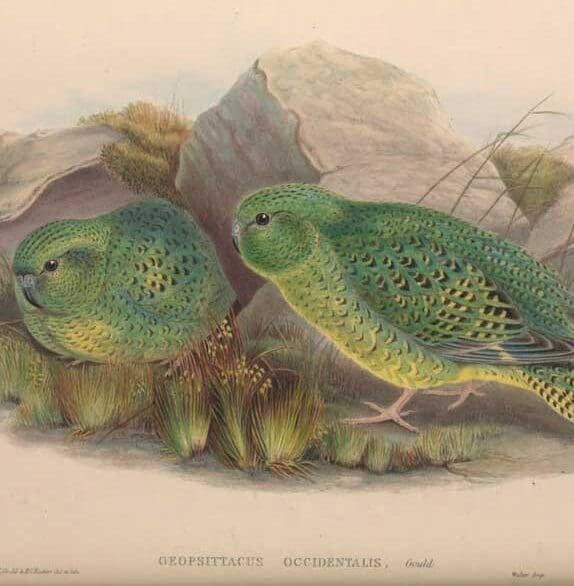Night Parrot
Also known as:
Spinifex Parrot, Nocturnal Ground Parrot, Porcupine Parrot, Night Parakeet
Also known as:
Spinifex Parrot, Nocturnal Ground Parrot, Porcupine Parrot, Night Parakeet

Pezoporus

occidentalis
Size:
23 cm (9 in)
Weight:
About 100g.
Subspecies including nominate:
one
Colour Adult:
Both adults yellow/green in colour mottled with dark brown, black and yellow; yellow/green foreneck, breast and flanks with black and yellow barring; bright yellow abdomen and undertail coverts; pale yellow on flight feathers forming underwing stripe; dark brown tail barred with yellow. Beak grey/brown. Eye black.
Colour Juvenile:
Reported to be duller than adults with yellow on throat and neck.
Call:
Calls are described as low, two-note whistle when alighting at water source at night; gives squeak when startled, and strange croaking note when alarmed.
More Information:
Content Sources:
CITES
BirdLife International
Bush Heritage Australia
Cornell Lab of Ornithology/Birds of the World
Parrots: A Guide to Parrots of the World, Juniper and Parr, 1998
Vanished and Vanishing Parrots, Forshaw, 2017.
Parrots of the World, Forshaw, 2006. 2010 edition
Lexicon of Parrots, Thomas Arndt.
Captive Status:
Not seen in aviculture.
Longevity:
—
Housing:
—
Diet:
—
Enrichment:
—
Nest Box Size:
—
Clutch Size:
4-5
Fledging Age:
—
Hatch Weight:
—
Peak Weight:
—
Weaning Weight:
—
World Population:
About 200 individuals (2021). Decreasing.
IUCN Red List Status:
Critically Endangered
CITES Listing:
Appendix I
Threat Summary:
Assessing the species’ status is difficult because of its nocturnal habits and desolate environment. It is believed that threats to the species vary across its range and may include predation by feral mammals, erosion and soil disturbance by domestic animals, food competition, disease, fire, illegal collection of birds or eggs and reduced water availability. In any given sub-population there is thought not to be any more than 30 individuals. The probable extreme fragmentation of the population poses a significant extinction risk.
Range:
Seen in scattered areas in arid interior of mainland Australia; recent reports from W Queensland.
Habitat:
Found in areas that are a combination of samphire flats with nearby lake systems and Spinifex sandplains. Also seen in mulga and saltbush habitats, with large freshwater pools, rocky areas, margins of salt lakes and grassy areas. Most recent studies have located them in or near mature spinifex grassland Triodia spp, where they roost during the day and also breed.
Wild Diet:
Seeds of Spinifex and various grasses including possibly Enneapogon purpurascens. Succulents are taken for water. May take fruits and green shoots of chenopods.
Ecology and Behaviour:
Usually solitary, active and ground dwelling; by day hides quietly in Spinifex vegetation where it is difficult to spot. Becomes active after dusk, where at least one bird was tracked flying up to 7km to foraging areas. There is evidence that they obtain moisture from succulents like Sclerolaena sp. May be sedentary in areas of favourable habitat.
Clutch and Egg Size:
4-5 eggs, 25.0 x 19.5 mm (1.0 x 0.8 in).
Breeding Season:
April-June; nest is a platform of sticks in an enlarged cavity burrowed into dense tussock grass.

![© Biodiversity Heritage Library [Public Domain] via Wikipedia An illustration depicts Night Parrots](https://parrots.org/wp-content/uploads/2023/01/wpt_night_parrottwo_1213-e1742839830207-100x100.jpg)